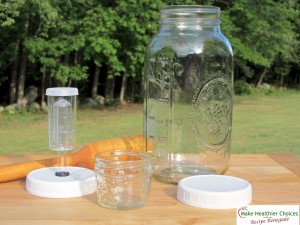Barbara O’Neill on Cultured and Fermented Foods
In this video, Barbara O’Neill says, “There’s a big difference between cultured foods and fermented foods.” I disagree. Well, sort of. Watch the video below and please let me know what you think!
A little research tells us that it’s rather simple: We can use cultures to ferment food. A culture is used to start the fermentation process of certain foods (like using kefir grains, or a kombucha SCOBY, or even sourdough starter), although fermentation can happen on it’s own via yeasts and bacteria that is present in the air. We can make our own sourdough culture (aka starter) using wild fermentation (capturing the yeasts in the flour and the air), or we can use one that is a purchased culture. Either way, we’re fermenting our sour dough bread.
ChatGPT Gives us a Rather Nice Explanation:
-
All cultured foods are fermented, but not all fermented foods are cultured.
-
Fermentation is the broader natural process; culturing is a specific, guided method within that.”
I Love Cultures for Health!
I find Culturesforhealth.com to be a great resource not only for cultures, but also for good, valid information. They have a large library of culturing e-books that can be downloaded for free. You can even purchase their cultures on Amazon.
Barbara O’Neill also mentions that we shouldn’t drink wine because the Bible tells us not to – “wine must never be touched.” Wasn’t it Jesus who turned water into wine? Maybe I’ve misunderstood this verse: 1 Timothy 5:23 “Drink no longer water, but use a little wine for thy stomach’s sake and thine often infirmities.” There are over 200 Bible Verses About Wine. You can find them at sarata.com.
MORE FROM ChatGPT
Fermented Foods
Definition:
Fermentation is a natural metabolic process where microorganisms — typically bacteria, yeasts, or molds — break down sugars and starches in food into other compounds such as lactic acid, alcohol, or acetic acid.
Key idea: The microbes transform the food chemically, producing acids or alcohols that preserve it and create new flavors and nutrients.
Examples:
- Sauerkraut (fermented cabbage by Lactobacillus)
- Kimchi
- Yogurt (lactic acid fermentation of milk sugars)
- Kombucha (tea fermented by yeast and bacteria)
- Sourdough bread (fermented by wild yeasts and lactobacilli)
What happens:
The microbes not only grow, but also change the food — for example, turning milk into tangy yogurt or cabbage into sour, preserved sauerkraut.

Cultured Foods
Definition:
“Cultured” means that specific strains of beneficial bacteria (a starter culture) have been intentionally added to a food to achieve controlled fermentation or to impart probiotics — even if no significant transformation of the food occurs.
Key idea: All cultured foods involve microorganisms, but not all undergo full fermentation. Sometimes culturing simply adds probiotics without major acid or alcohol production.
Examples:
- Yogurt (cultured and fermented)
- Kefir (cultured with a specific kefir grain community)
- Some cheeses (cultured milk curds, may or may not be fermented long-term)
- Probiotic drinks (often cultured, not always fermented)
- Cultured butter (cream inoculated with lactic acid bacteria before churning)
⚖️ In Short:
| Feature | Fermented Food | Cultured Food |
|---|---|---|
| Microbe Source | Naturally occurring or added | Usually added (starter culture) |
| Process | Microbes chemically transform the food | Microbes grow but may not fully ferment |
| Goal | Preservation, flavor, nutrient change | Probiotic benefits, flavor development |
| Examples | Sauerkraut, kimchi, kombucha | Yogurt, kefir, cheese, cultured butter |
